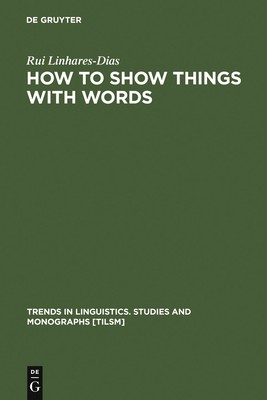
- We will send in 10–14 business days.
- Author: Rui Linhares-Dias
- Publisher: Walter de Gruyter
- ISBN-10: 3110179954
- ISBN-13: 9783110179958
- Format: 16.4 x 23.5 x 3.6 cm, hardcover
- Language: English
- SAVE -10% with code: EXTRA
Reviews
Description
How to Show Things with Words is an interdisciplinary research study at the interface between linguistics and philosophy which sheds new light on the narrative-theoretical issue of proximal vs. distal stance adoption in discourse.
Narrative distance ultimately depends on the epistemological source of the information conveyed, but English and other Indo-European languages have no inflectional systems for (en)coding that source of knowledge. To fill in the gap, speech act theory is (re)considered in the light of philosophical research on linguistic functions and a parallel is drawn between grammaticalized evidential categories and the objectifying acts of Husserl's phenomenology of constitution. These intuitive vs. signitive intentional acts do, indeed, roughly correspond to direct vs. indirect evidentiary forms and can be inferred from the temporal-perspectival organization of discourse by the so-called intimation or announcement function of language-systems. It turns out that perspectival immediacy requires tenses with overlapping event- and reference-points, but predictions of the sort are non-monotonic forms of reasoning defeasible by quantificational aspect distinctions, on the one hand, and inherent meaning considerations, on the other. To substantiate this claim, the bulk of the book provides an in-depth formal semantic account of tense, aspect and Aktionsart, interwoven with a detailed analysis of the cognitive processes associated with eventuality-description types.
The book adresses an audience of linguists in general, formal semanticists, cognitive scientists, philosophers and narratologists with an interest in natural language semantics.
EXTRA 10 % discount with code: EXTRA
The promotion ends in 10d.16:25:27
The discount code is valid when purchasing from 10 €. Discounts do not stack.
- Author: Rui Linhares-Dias
- Publisher: Walter de Gruyter
- ISBN-10: 3110179954
- ISBN-13: 9783110179958
- Format: 16.4 x 23.5 x 3.6 cm, hardcover
- Language: English English
How to Show Things with Words is an interdisciplinary research study at the interface between linguistics and philosophy which sheds new light on the narrative-theoretical issue of proximal vs. distal stance adoption in discourse.
Narrative distance ultimately depends on the epistemological source of the information conveyed, but English and other Indo-European languages have no inflectional systems for (en)coding that source of knowledge. To fill in the gap, speech act theory is (re)considered in the light of philosophical research on linguistic functions and a parallel is drawn between grammaticalized evidential categories and the objectifying acts of Husserl's phenomenology of constitution. These intuitive vs. signitive intentional acts do, indeed, roughly correspond to direct vs. indirect evidentiary forms and can be inferred from the temporal-perspectival organization of discourse by the so-called intimation or announcement function of language-systems. It turns out that perspectival immediacy requires tenses with overlapping event- and reference-points, but predictions of the sort are non-monotonic forms of reasoning defeasible by quantificational aspect distinctions, on the one hand, and inherent meaning considerations, on the other. To substantiate this claim, the bulk of the book provides an in-depth formal semantic account of tense, aspect and Aktionsart, interwoven with a detailed analysis of the cognitive processes associated with eventuality-description types.
The book adresses an audience of linguists in general, formal semanticists, cognitive scientists, philosophers and narratologists with an interest in natural language semantics.


Reviews